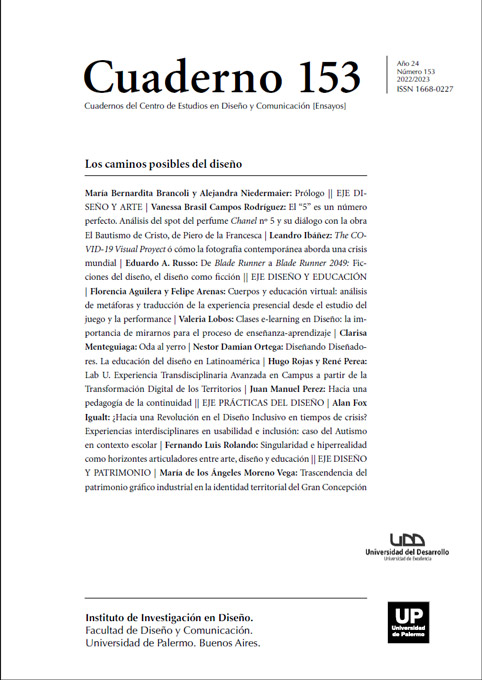Cuerpos y educación virtual: análisis de metáforas y traducción de la experiencia presencial desde el estudio del juego y la performance
Resumen
Al posicionarnos en un escenario de resguardo sanitario, donde realizar clases virtuales se torna una necesidad, se manifiestan una serie de dificultades a nivel comunicacional, afectivo y sobre la experiencia educativa en general, que perjudica en específico al cuerpo del estudiantado universitario y su capacidad para generar vínculos y comunidades orgánicas. Comprendemos entonces la clase presencial como un espacio de interacción por medio de códigos corporales y estímulos sensoriales tangibles, los cuales al pasar a formato de videoconferencia se ven reducidos a la mediación de un único espacio visual, de interfaz cuadrada y sonoridad por lo general desfasada por el vaivén de la señal.
Citas
Ayala, R. (2021). Un zoom a la educación virtual: biopolítica y aprendizaje centrado en el estudiante. Educación Médica.
Caillois, R. (1967). Los Juegos y los Hombres: la Máscara y el Vértigo. FCE, México.
Eldokhny, A. A., & Drwish, A. M. (2021). Effectiveness of Augmented Reality in Online Distance Learning at the Time of the COVID-19 Pandemic. International Journal of Emerging Technologies in Learning, 16(9).
Goodwyn, H. (2021). Coping Strategies in the 2020-21 Virtual Classroom: A Tribute to my Students. Nineteenth-Century Gender Studies, 17(1), 1-8.
González-Patiño, J. y Esteban-Guitart, M. (2021). Revista de Educación a Distancia. Núm. 65, Vol. 21. Artíc. 8 La transformación hacia experiencias expandidas en educación superior: curso #UAMskills de identidad digital.
Guzmán, A. (2016). Revelación del cuerpo. La elocuencia del gesto. México: Editorial Instituto Nacional de Antropología e Historia.
Hu, X.; Zhang, H. & Rhea, Z. M. (2016). Alternate Reality Game in Education: A Literature Review. AARE, 1-16.
Klemmer, S.; Hartmann, B. y Takayama, L. (2006). How Bodies Matter: Five Themes for Interaction Design. Stanford University.
Mandoki, K. (2008). Estética cotidiana y juegos de la cultura: Prosaica l (Vol. 1). Siglo xxi.
McGonigal, J. (2011). Reality is broken: Why games make us better and how they can change the world. Penguin.
Rivera Cusicanqui, S. (2018). Un mundo chi’xi es posible. Ensayos desde un presente en crisis. Buenos Aires: Editorial Tinta Limón.
Rodrigues, P. & Bidarra, J. (2014). Transmedia storytelling and the creation of a converging space of educational practices. International Journal of Emerging Technologies in Learning-(iJET), 9, 42-48.
Recursos electrónicos Angeli A.; Ghersinich, E. & Lawson, S. (2021). A mind needs its body. Connecting digital & physical educational environments, disponible en https://studentawards.mediaarchitecture.org/mab/project/9
Gomez-Venegas D. (2021). “Inter-Fases de los cuerpos (in)dociles”, Conferencia Laboratorio. Constituir lo Común de Núcleo Milenio Arte, Performatividad y Activismo.
Herigstad, D. (2014). Discovering new media space, TEDxTransmedia https://www.youtube.com/watch?v=mabgFkt9scg
Ibáñez, F. (2021). “Cuatro consecuencias de la Fatiga de Zoom y cómo combatirla”, disponible en https://observatorio.tec.mx/edu-news/fatiga-zoom-estudio
Infante, M. (2021). “Dramaturgias No Humanas”, Seminario Fundación Teatro a mil laboratorio escénico.
Reed, M. (2021). “Should showing faces be mandatory”, disponible en www.insidehighered.com/blogs/confessions-community-college-dean/should-showing-faces-be-mandatory
Moses, T. (2020). “5 reasons to let students keep their cameras off during Zoom classes”, disponible en https://theconversation.com/5-reasons-to-let-students-keep-their-cameras-off-during-zoom-classes-144111
Harvey, J. (2020). “Face value: why won’t students turn their cameras on?”, disponible en https://wonkhe.com/blogs/face-value-why-wont-students-turn-their-cameras-on/
Los autores/as que publiquen en esta revista ceden los derechos de autor y de publicación a "Cuadernos del Centro de Estudios de Diseño y Comunicación", Aceptando el registro de su trabajo bajo una licencia de atribución de Creative Commons, que permite a terceros utilizar lo publicado siempre que de el crédito pertinente a los autores y a esta revista.


